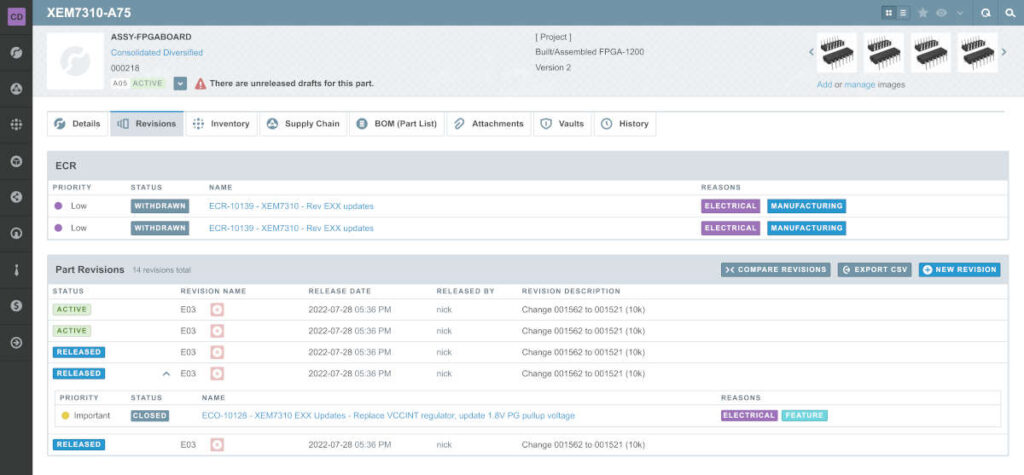
Getting to production intent is never a straightforward process. Changes to a product’s design can happen for a variety of reasons along the way. Parts may have to change to satisfy performance requirements. They may need to be specified differently due to price, availability, compliance, or other factors.
If a product is complex enough, all these factors may require successive changes to the product’s makeup. When that occurs, keeping track of all the twists and turns requires a purpose-built system like Product Lifecycle Management (PLM) software.
A PLM system manages the changes – and the reasons for the changes – during the course of product development. It does more than keep track of the quantities needed. PLM saves the specifications required of all components that go into that production-ready product within an easily searchable database called the Item Master. PLM is also designed to be the connection between design, engineering, production, quality, and supply chain departments. This connection is built to make it easy to share this information and reduce errors. In sum, these PLM capabilities have several benefits for product engineers and others in the company.
Saving Time by Easily Spec’ing Currently Used Parts

Using a system based on an item master database means parts can be found quickly and kept up to date easily. Instead of checking spreadsheets of past builds or out-of-date ‘master part list’ spreadsheets, engineers and designers can query the item master database of all currently used parts by part type, value, function, usage, availability, or any number of custom specifications to find the part they need.
Because the PLM item master database is the single source of truth for the entire organization, engineers can be assured that it’s the most up-to-date source of information in the company. The item master database can be shared and updated with everyone in the firm including purchasing and quality departments. That means each department works from and updates the same database as changes happen, instead of their own spreadsheets.
Don’t Repeat Mistakes. Manage the Changes and Document the Rationale.

When a product is developed, there tends to be a number of people working on the process. That leads to many changes along the way and by different functional groups in the process. Instead of struggling to keep a series of spreadsheets current across the company, bring all those people and changes together in PLM’s item master database. Everyone is working off the latest information, not waiting to hear about updates, or worse – not knowing about them at all.
Those changes are the decision-making that drives the project to the final product it becomes. Without the use of a PLM system, this information becomes muddied in discussions lost to time or in forgotten emails buried on a company’s servers. When a PLM is used, this valuable information is stored with the project. The item master database makes the information available whenever questions arise. Searchable and accountable decisions mean the reasons are kept as well as the change itself. It provides the company the ability to understand the hows and whys of the current iteration, as well as the ability to transfer that learned information to future projects.
Taking the Headache out of Handoffs to Production
Making sure all the correct part and build information makes it to the manufacturing department is key. That’s where Aligni PLM comes in. Since the product designers and engineers have been working from the same part information database, the correct data can be easily extracted. Inside Aligni PLM, product build information is already maintained in a production- and supply-chain-ready BOM format. Recompiling information for hand off is not necessary, reducing errors and omissions.
Aligni takes build data management a step further – and a step further into the supply chain. Suppliers are automatically connected to parts and quantities needed. This reduces double work by purchasing personnel. For most parts, it’s just call and order. Or upgrade to Aligni MRP, where component ordering can take place inside Aligni’s ActiveQuote vendor portal, for even greater efficiency and oversight.
Bringing it All Together
There’s a reason database systems are faster to use than spreadsheets – they’re designed from the start to manage the large amounts of the information product development processes tend to rely on. The larger the data to search through, the more efficient a database system is over something two-dimensional, like spreadsheets. Using an item master database is not all about speed. The costs of making mistakes can be high when information is not centrally located.
Ready to streamline your product development process? Make sure build management is done correctly and make sure everyone is in the loop. Sign up online with Aligni PLM today.
Start your 30-day free trial
Helping You Make Great Things…Better.

